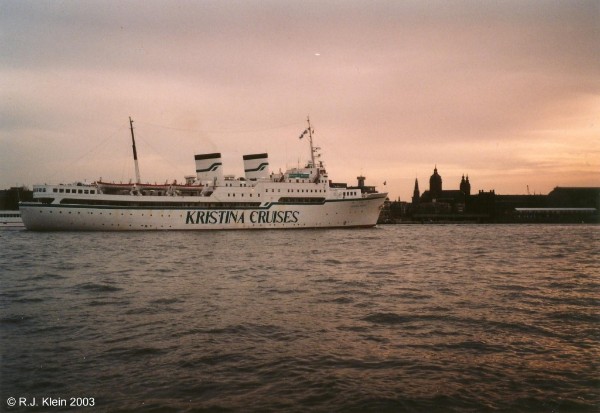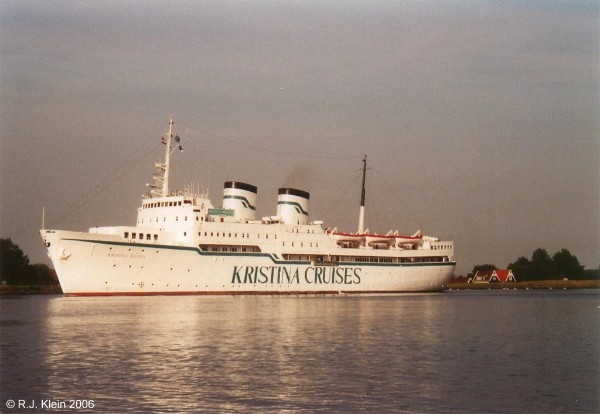Kristina Regina

Kristina Regina is a handsome little vessel. Het tonnage is just 4.295 and she is 99,83 meters long, 15,25 meters wide and her draft is 5,50 meters. The ship was built in 1959, when she was launched at the 19th of march at the Oskarshamn Shipyard in Oskarshamn, Sweden under yardnumber 353. She was named Bore for the Bore Shipping Company for the ferryservice between Abo (Turku) in Finland and Mariehamn and Stockholm in Sweden. Normally, the Bore Steamship Company named their ships Bore, followed by the roman numbers I, II or III. But at the time this new ship entered service, there was a slight problem because there were three ships sailing. So this is why the ship was just called Bore. A IV was not an option. This is also why the ship was often referred to as 'Nolla-Bore', meaning 'Bore Zero'. Bore was the last of a kind, being the last steamship build in Scandinavia. She has a very classic profile, with two rather large but well-proportioned funnels midships, two masts and a promenade deck. Her looks were very traditional, because the older Finnish Companies were very keen on their traditions. The time of the modern carferries just started but the Finnish companies were not likely to add these new kind of ferries to their fleets. The Bore Steamship Company worked together with two other companies, the Svea Line and the Finland Steamship Company under the banner of Yhteisliikennevarustamot (also known as De Samseglande) and these companies made firm arrangements with each other so they could keep working seperately without interferring too much. The Finland Steamship Company and the Svea Line were not too keen of the new modern carferries and so in was difficult for Bore Steamship Company to built a modern carferry without breaking the agreements. This is why the Bore was built as a very traditional two-funneled liner, not too large in size, but she was also built with a ro-ro deck accessible via a side-door. In fact, she was the first ro-ro ship in Finland. The ship was delivered to her owners in 1960 and since then she started her sailings. Next to her original route, she was also sailing the Stockholm to Helsingfors ferry service and the service between Mariehamn and Stockholm.
In july 1970, Bore collided with the Dutch ship Edda close to Turku. There was some damage, but nothing severe. The ship sailed steadily for the company, that was absorbed into the Silja Line from 1975 onwards. This was in fact a combination of the three former companies that had worked together for a long time, but from 1970 onwards they started operating under one name. The ships kept their own funnelcolours however, just with a Silja Line logo added to the ships too. Finland Steamship Company and Svea Line painted their ships totally white after the merger, but Bore kept her own corn-coloured hull. In august the following year, Silja Line discontinued the sailings of the former Bore Line and the Bore was taken out of service and laid up. Just 16 years old by then, the ship was still young and on the 10th of october 1977 she was bought by the Jacobs Line, a company owned by the former owner of the Bore Shipping Company. She was renamed Borea and again commenced sailings in the northern waters of Europe, starting a ferryservice between Skalleftea and Jacobstad. In january 1979, the ship was chartered as a housing vessel for workers at an oilrig near the Scottish coast and she returned to her sailings from september that year. Another charter followed as a housing vessel for workers at the freedom monument in Alger, Algeria.

In april 1984, the Borea was sold to Ab Helsingfors Steamship Company to be chartered to the Finnish Aura Line, and for the summer of 1984 she again sailed her old route as a small steamer, a resurrection from the past. During her Aura Line summerseason, a young boy named Johnny Sid also travelled aboard her and we hear more of him later. Aura Line was declared bankrupt after the summerseason and the ship was laid up in the Finnish port of Turku from the following october. One year later, in october 1985, she was sold to a Canadian firm called Aqua Culture Industries (trading as Vanderbildt Steamship Company) based in Vancouver, and it was meant to rebuilt the Borea as a luxury cruiseliner with the new name of Vanderbildt. Although it seemed possible, nothing happened and the ship stayed in Turku.
Finally, the small ship was bought by a company owned by the Partanen family from Kotka, Finland named Rannikolinjat, based at Turku and founded in 1985. This company started her sailings with the even smaller Kristina Brahe, that was built in 1943 as a US war ship. The Borea was renamed Kristina Regina, after the 17th century Queen Kristina of Sweden and Finland. in april of that year, and rebuilt as a cruiseship, not a luxury though. She was a very classic ship and also her interiours were to be very classical with lots of wood. A big rebuilding took place and her old steamengine was replaced by a more modern dieselengine. Also, the cardeck was rebuilt and new cabins were added here. The rebuilding took more then a year and she finally sailed her first Baltic cruise in april 1989. Luckily, her profile largely was kept intact, with just some small alterations. The company was restyled as Kristina Cruises the following year and the owner of the company was also her captain. Kristina Regina could now take 290 passengers and 55 crew on board and she sailed at a modest 16,5 knots. Mostly, she cruised the Baltic, but she was also seen in other parts of Europe. A large modernisation took place in 2001, but she still kept her classic interiours and exteriour. Ships like her are now very rare to see sailing with passengers and in 2010 it was announced the ship would be taken out of service. This because she was not up to the 2010 SOLAS requirements. But the Partanen family were very attached to their little ship and they did not want to see her scrapped. So that is why Mikko Partanen contacted a man named Johnny Sid (we remember hin from that 1984 summerseason) who just had tried to preserve the Finnjet of 1976. This had come to nothing and this is why he was asked to try and preserve the former Bore. Because Johnny loved the small ship he did not have to think about it twice. He started up the SS Borea AB at Turku so she could be rebuilt and re-emerge as a floating hotelship in het former homeport. Her last cruise started at the 18th of august 2010 and it took her from Helsingfors to St-Petersburg. The ship was repainted in the colours of the Bore Shipping Company and re-emerged again as Bore on the 10th of october 2010 with a grand opening. Instead of a long and painfull proces like we have seen with the conversion of the former Holland America Line flagship rotterdam, the ship was docked at her last home Turku within a few months after she was taken out of service. She was finally opened to the public in the middle of 2011 after the finding of a good mooring site proved to be a challenge. Although we again lost a great little ship for cruising, her preservation is a good thing, saving a part of Scandinavian shipping history for future generations. The plan is, to use her as a static ship that sails (not) between Turku and Stockholm, but everything will be offered as if she is, like onboard entertainment, meals and a good night sleep. From the outside, she looks like she is the Bore and from the inside she looks like she is Kristina Regina so her whole history can be found in her new disguise.

